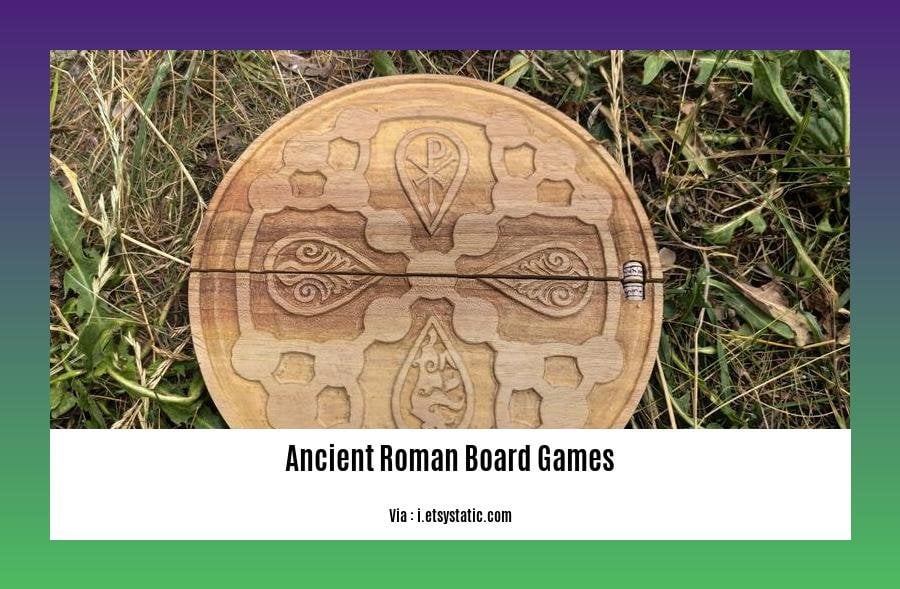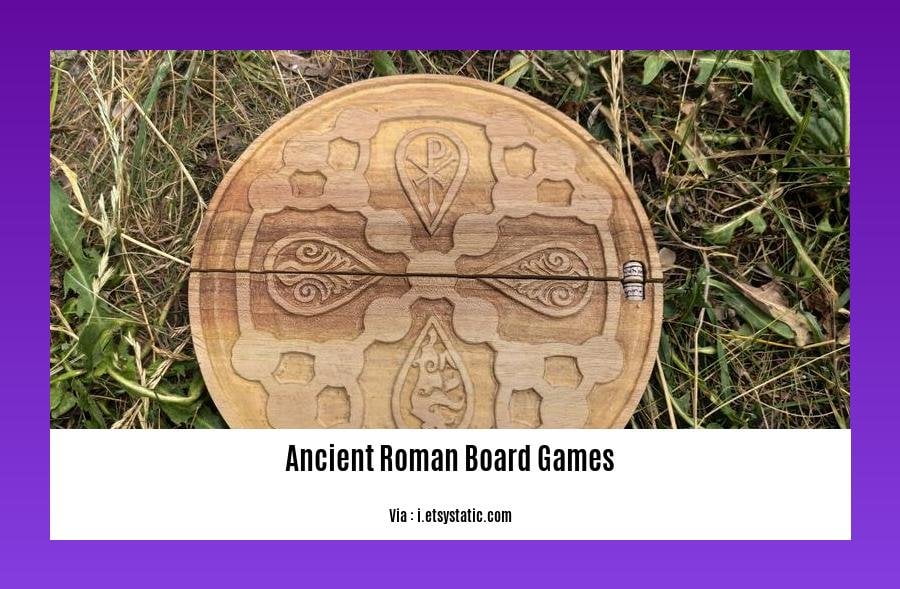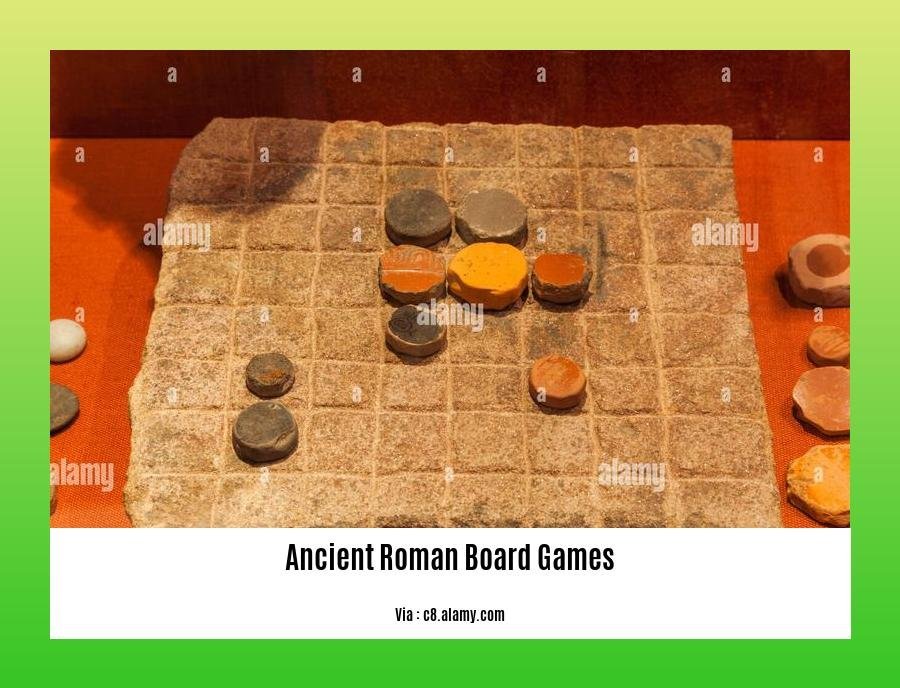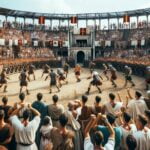Journey back in time to the bustling streets of ancient Rome and uncover the fascinating world of their board games in [Ancient Roman Board Games: Uncovering the Pastimes of a Mighty Civilization]. From the strategic rolls of dice to the clever moves of pieces, these games offer a glimpse into the recreational activities and cultural values of this remarkable civilization. Prepare to be captivated as we explore the intricate designs, symbolic meanings, and social significance of these ancient pastimes that brought people together for hours of entertainment and friendly competition.
Key Takeaways:
- Ludus Latrunculorum:
A strategic board game similar to chess, popular among Roman soldiers.
Ludus Calculorum:
A general term for Roman board games that includes games played with counters, pieces, or dice.
Tesserae:
The collective term for Roman dice, used in various games of chance and strategy.
Tali:
Specialized four-sided dice used in games like “Duodecim Scripta.”
Duodecim Scripta:
An early form of backgammon played on a 24-point board with dice.
Rota:
A game of chance involving a circular board with numbered segments and a spinning pointer.
Terni lapilli:
- A simple 3×3 grid board game, similar to tic-tac-toe with variations in gameplay.
Ancient Roman Board Games: Insights into the Leisure of a Mighty Civilization

In the heart of ancient Rome’s bustling streets and grand villas, there existed a captivating world of board games that mirrored the strategic brilliance, entertainment, and social interactions of this iconic civilization. From the strategic Ludus Latrunculorum to the chance-driven Rota, these games provide a glimpse into the daily lives of Romans from all walks of life.
Dice and Strategy: Ludus Latrunculorum
Ludus Latrunculorum, often regarded as the Roman chess, captivated military strategists and civilians alike. The game’s complexity and tactical possibilities mirrored the strategic prowess of Roman legions, where players moved their pieces across a grid, aiming to capture their opponent’s counters. With its emphasis on planning, foresight, and adaptability, Ludus Latrunculorum stood as a testament to Roman military acumen.
Rolling the Bones: Tesserae and Tali
Chance played a significant role in ancient Roman board games, and Tesserae, the collective term for Roman dice, were ubiquitous. These small, often bone-made cubes bore numbers that determined a player’s fate. Tali, a specialized form of dice with four sides, added an extra layer of unpredictability to games like Duodecim Scripta, an early version of backgammon. The clatter of dice and cries of triumph echoed through Roman homes, taverns, and public squares, as players tested their luck and skill.
A Game of Skill and Strategy: Duodecim Scripta
Combining elements of strategy and chance, Duodecim Scripta captivated Roman players with its intricate rules and challenging gameplay. Played on a board marked with 24 points, Duodecim Scripta required players to use dice rolls to move their pieces around the board, aiming to reach their home row before their opponent. This game fostered strategic thinking, risk assessment, and the ability to adapt to the unpredictable nature of dice rolls, mirroring the challenges faced by Roman military leaders on the battlefield.
A Game of Chance: Rota
In contrast to the strategic Ludus Latrunculorum and Duodecim Scripta, Rota relied solely on chance. Players spun a pointer on a circular board divided into numbered segments, determining their fate based on where the pointer landed. Rota provided a lighthearted diversion, encouraging players to embrace the unpredictability of life and enjoy the thrill of the unknown.
A Universal Pastime
Ancient Roman board games transcended social boundaries, bringing together individuals from all walks of life. Soldiers engaged in strategic games during military campaigns, while families gathered around game boards in their homes. Taverns and public spaces buzzed with the excitement of dice rolls and the camaraderie of players. These games not only provided entertainment but also fostered social connections, strategic thinking, and a sense of community.
As we delve into the intricacies of ancient Roman board games, we gain a deeper appreciation for the cultural and historical significance of these pastimes. They offer a glimpse into the daily lives of Romans, shedding light on their strategic thinking, social interactions, and love of chance and competition. These games continue to fascinate us today, serving as reminders of the enduring legacy of ancient Rome and the universal appeal of play.
Discover the extensive ancient origins card list that unveils the captivating array of cards from the Ancient Origins expansion, immersing you in the world of Pokémon trading cards.
For an exhaustive ancient origins pokemon card list, delve into the realm of Pokémon TCG, where you’ll encounter a comprehensive catalog of cards featuring your favorite Pokémon from the Ancient Origins expansion.
Explore the realm of ancient grains and their remarkable health benefits with our in-depth guide to ancient power grains. Discover the diverse range of ancient grains, including quinoa, amaranth, and farro, and unlock their nutritional secrets.
Rules and Gameplay of Ancient Roman Board Games

In the heart of the Roman Empire, where emperors ruled and legions marched, there existed a vibrant world of entertainment and leisure. Among the various pastimes enjoyed by the ancient Romans, board games held a prominent place, offering a blend of skill, chance, and social interaction.
Step into the shoes of a Roman citizen and embark on a journey through time as we uncover the fascinating world of their board games. From the strategic maneuvers of Ludus Latrunculorum to the unpredictable rolls of Tesserae, each game tells a story of Roman culture, values, and daily life.
Key Takeaways:
- Ancient Roman board games mirrored the strategic prowess and adaptability of the Roman legions.
- Ludus Latrunculorum, similar to chess, demanded strategic thinking and tactical expertise.
- Tesserae and Tali, Roman dice, injected unpredictability and excitement into various games.
- Duodecim Scripta, an early form of backgammon, required strategic planning and risk assessment.
- Rota, a game of pure chance, provided lighthearted entertainment and encouraged embracing unpredictability.
- Board games in ancient Rome transcended social boundaries, fostering strategic thinking, social connections, and a sense of community.
- These games offer glimpses into the daily lives, cultural values, and strategic mindset of ancient Romans.
Ludus Latrunculorum: The Roman Chess
Imagine yourself in a Roman villa, surrounded by intricately carved game boards and pieces. Ludus Latrunculorum, the Roman equivalent of chess, captivates players with its strategic depth and military overtones. The game, played on a checkerboard-like board, pits two armies against each other in a battle of wits and tactics.
Rules and Gameplay:
- Ludus Latrunculorum is played on an 8×8 board with two sets of 16 pieces, typically black and white.
- Each player’s pieces start on their respective sides of the board.
- Players take turns moving their pieces one space in any direction, but they cannot move through or capture their own pieces.
- When a player’s piece lands on a space occupied by an opponent’s piece, the opponent’s piece is captured and removed from the board.
- The objective of the game is to capture all of your opponent’s pieces or to block them so that they cannot move.
Tabula: The Roman Backgammon
As the sun sets over the Roman countryside, families gather around a Tabula board, engrossed in the suspense and excitement of this ancient version of backgammon. With its combination of strategy and luck, Tabula captivates players of all ages and skill levels.
Rules and gameplay:
- Tabula is played on a board with 24 points arranged in three rows.
- Each player has 15 pieces, which are placed on the board according to specific starting positions.
- Players take turns rolling three dice and moving their pieces around the board according to the numbers rolled.
- The goal of the game is to move all of your pieces off the board before your opponent.
Tesserae and Tali: The Roman Dice
In the taverns and gambling dens of ancient Rome, the clatter of Tesserae and Tali, Roman dice, fills the air. Made from various materials such as wood, bone, or ivory, these dice add an element of chance and excitement to a wide range of games.
Rules and gameplay:
- Tesserae are six-sided dice, similar to modern dice.
- Tali are four-sided dice, with each side marked with a different symbol.
- Tesserae and Tali are used in various games, including gambling games, to determine the starting player, or to move pieces on a board.
Conclusion
The board games of ancient Rome paint a vibrant picture of a civilization that valued strategic thinking, social interaction, and the thrill of competition. From the military strategy of Ludus Latrunculorum to the unpredictable rolls of Tesserae, these games provide a glimpse into the daily lives, cultural values, and strategic mindset of the ancient Romans.
Sources:
Significance of board games in Roman culture
Board games were a prominent aspect of daily life in ancient Rome, offering entertainment, social interaction, and strategic challenges to people from all walks of life. Their popularity is evident in archaeological discoveries, such as the burial of a player with over 800 game pieces in northern Italy and the finding of 30 gaming pieces in a coffin in Kent.
These games provide insights into the societal significance of gaming during that period and the extent of cultural exchange between Rome and Scandinavia. The rough and ready nature of the game board indicates its widespread use and popularity among the Romans.
Key Takeaways:
- Board games were incredibly popular in ancient Rome, transcending social boundaries and bringing together individuals from all walks of life.
- They were not just mere pastimes but also tools for strategic thinking, fostering social connections, and promoting a sense of community.
- Ancient Roman board games offer valuable insights into the daily lives, cultural aspects, strategic thinking, social interactions, and love for chance and competition among the Romans.
- They serve as reminders of the enduring legacy of ancient Rome and the universal appeal of play.
Sources:
- Teaching History with 100 Objects – Roman game board
- Ancient Roman Board Game Found in Norway
Archaeological evidence related to board games
Hello, fellow history enthusiasts! Today, we embark on a captivating journey through time to explore the fascinating world of ancient Roman board games. Join me as we delve into the depths of archaeological discoveries that shed light on the recreational pastimes of this mighty civilization.
Key Takeaways:
Archaeological evidence reveals that board games were prevalent in ancient Roman society, enjoyed by people from all walks of life.
Excavations at sites such as Pompeii and Herculaneum have yielded a wealth of artifacts, including game boards, pieces, and dice, providing valuable insights into the rules and gameplay of these ancient pastimes.
The popularity of board games in ancient Rome is attributed to their versatility, serving as sources of entertainment, education, and social interaction.
Archaeological evidence suggests that board games were not confined to the elite but were enjoyed by individuals across the social spectrum, fostering a sense of community and camaraderie.
The discovery of board game artifacts in various regions of the Roman Empire highlights the widespread diffusion of these games, facilitating cultural exchange and interaction between diverse communities.
Hang on tight as we uncover the secrets hidden beneath the sands of time, piecing together the puzzle of ancient Roman board games through the lens of archaeological discoveries.
Unraveling the Enigmatic World of Ancient Roman Board Games
Picture this: archaeologists meticulously excavating the ruins of ancient Roman cities, their hearts pounding with anticipation. As they carefully brush away the layers of dust and debris, they uncover a treasure trove of artifacts that transport us back to a time when board games were not just mere pastimes but held profound cultural significance.
Imagine stepping into the homes of ancient Romans, where families and friends gathered around game boards, their faces illuminated by the flickering flames of oil lamps. The clatter of dice, the hushed whispers of strategy, and the laughter of victors filled the air, creating a vibrant tapestry of social interaction.
A Glimpse into Ancient Roman Game Boards and Pieces
Archaeological excavations have unearthed a diverse array of game boards, each with its unique design and intricate carvings. These boards, often made of wood, stone, or bone, provide tangible evidence of the ingenuity and creativity of ancient Roman artisans.
Game pieces, meticulously crafted from materials such as glass, pottery, or ivory, have also been discovered in abundance. The exquisite craftsmanship and intricate details of these pieces hint at the importance and popularity of board games in ancient Roman society.
The Enduring Legacy of Ancient Roman Board Games
The archaeological evidence paints a vivid picture of the enduring legacy of ancient Roman board games. These games transcended time, becoming cherished possessions passed down from generation to generation. They served as more than just entertainment; they were symbols of cultural identity, fostering a sense of continuity and connection with the past.
Today, these archaeological discoveries captivate us, offering a glimpse into the daily lives and social interactions of our ancient Roman ancestors. They remind us of the universal human desire for play, competition, and the joy of shared experiences.
Additional Resources:
FAQ
Q1: What were some of the most popular board games in ancient Rome?
A1: Some of the most popular board games in ancient Rome included Ludus Latrunculorum (a strategic game similar to chess), Ludus Calculorum (a general term for Roman board games involving counters, pieces, or dice), Tesserae (Roman dice used in various games), Tali (specialized four-sided dice), and Duodecim Scripta (an early form of backgammon).
Q2: How did board games reflect Roman culture and society?
A2: Board games in ancient Rome provided insights into the societal significance of gaming during that period. The popularity of board games among Roman soldiers, for example, highlighted the strategic and tactical elements of these games, while the use of board games in religious rituals and festivals reflected their cultural and social importance.
Q3: What materials were used to make Roman board games?
A3: Roman board games were typically made from wood, bone, ivory, or stone. Game boards could be made from wood, marble, or even metal, while game pieces were often made from bone, ivory, glass, or clay. Dice were commonly made from bone or ivory, and some games also incorporated the use of small stones or pebbles.
Q4: Where have archaeologists discovered evidence of Roman board games?
A4: Evidence of Roman board games has been found across the Roman Empire, including Italy, Greece, Egypt, and Britain. Archaeological excavations at Roman sites have uncovered game boards, pieces, and dice, providing valuable insights into the recreational activities and pastimes of the ancient Romans.
Q5: How did Roman board games compare to those from other ancient civilizations?
A5: Roman board games shared similarities with board games from other ancient civilizations, such as the Egyptians, Greeks, and Persians. Some games, like Senet and Mehen from ancient Egypt, involved moving pieces around a board according to dice rolls, while others, like Petteia from ancient Greece, featured strategic elements and the capture of opponent’s pieces. The widespread popularity of board games across different cultures highlights their universal appeal as a form of entertainment and social interaction.
- Discover the Borough of Frenchtown, NJ: A Delaware River Town Blending History, Art & Nature - November 22, 2024
- Discover Clarks Grove, MN: A Small Town with a Big Heart - November 22, 2024
- Califon Borough, NJ: A Small Town with a Big Heart (and Rich History) - November 22, 2024













